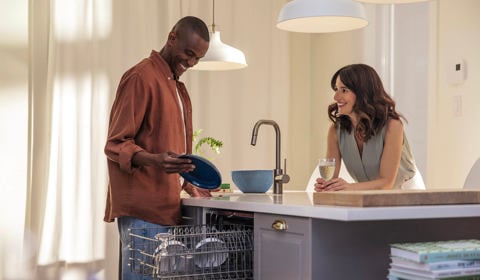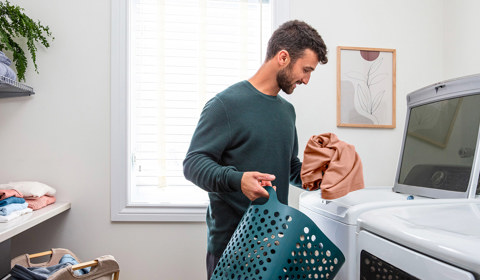Greener renovations: Discover the Logisvert Efficient Homes program
May 7, 2024 4 minutes reading"Before starting any type of renovation work, think green," advises Emmanuel Cosgrove, co-founder of Écohabitation and senior LEED evaluator. Why? Because improving your home's energy efficiency is likely to be more comfortable and cost-effective, in both the short and long term, than simply changing the bathroom tiles.

"In any project, if you don't take your energy costs into account, it's like investing in a '78 Plymouth [Editor's note: a sleek but unreliable car]," he says. "It's going to look good, but it's going to cost a lot of money and give you very little in terms of peace of mind and profitability."
With generous grants available to green renovators from both the provincial and federal governments, it would be foolish not to "think green" before picking up a hammer. "At this point, you're almost getting paid to renovate," laughs Mr. Cosgrove.
Financial support for better energy efficiency
When it comes to renovating your home, the opportunities are near endless. But thanks to Hydro-Québec's LogisVert Efficient Homes program, improving your home’s energy efficiency should be at the top of your list. This residential home financial assistance program offers financial assistance to help you improve your home’s energy efficiency.
Install a heat pump
Did you know that a heat pump can be up to three times more efficient than electric baseboard heaters for winter heating? And during the warmer months, it cools your home just as well as an air conditioner.
You could receive up to $6,700 from the LogisVert program to help pay for the purchase of an efficient heat pump.
"With a heat pump, you can easily save between $200 and $300 per winter," estimates Emmanuel Cosgrove. "Since it also cools your home during the summer, it pays for itself pretty quickly, in addition to increasing comfort considerably."
Spray eco-friendly insulation in the attic
Is your attic accessible? If so, consider adding a few centimeters of cellulose fibre: an effective, 100% natural insulator made from recycled wood fibres.
"Insulation specs for attics haven’t always been up to today's standards. Plus, over time, the insulation sags and becomes even less effective. [Adding cellulose fibre], which provides effective ventilation, is an easy way to maintain control of the interior temperature," says contractor François Thibodeau.
The LogisVert program offers $1,500 in financial support to people who have their attic insulated and their windows caulked by an expert. Clearly, you can't do without it!
Upgrade your heating system
In Quebec, more than 99% of electricity comes from clean, renewable sources. If you still have an oil or gas heating system, Emmanuel Cosgrove recommends against getting rid of it completely (to avoid unnecessary pollution). Instead, you can move to a dual-energy system that allows you to use electricity—a cost-effective, greener form of energy—as much as possible.
When you replace your central heating system, you can get up to $22,000 in financial assistance if you opt for equipment eligible under the LogisVert program. And the best part? You don't have to do anything to get this assistance! The amount will be deducted directly from the installation company's invoice.
Choose energy-efficient appliances
Has one of your household appliances recently called it quits? Take the time to compare your options and discover the advantages of more energy-efficient models.
Under the LogisVert program, you could receive $250 to put towards the purchase of a new induction range or heat pump dryer.
More great ideas!
Install Hilo at home
Having a Hilo smart home, where energy use can be carefully controlled and monitored thanks to connected devices, pays off—for the environment and your wallet.
Plus, participating in Hilo reduction challenges during peak consumption periods earns you cash rewards for your good energy-use habits. The average household reward for the winter 2023-2024 season was $1351.
All that’s required is agreeing to the automatic lowering of your smart thermostats for electric baseboard, radiant floor, or central heating during periods when everyone is heating at the same time. To maximize your rewards, you should also try to limit the use of appliances and hot water.
What's more, by programming your smart thermostats and other connected devices, you can save up to 15%2 on your annual electricity bill.
"It’s a win-win situation," says Emmanuel Cosgrove. "Hilo solutions are nice and easy-to-use tools that help us reduce our energy consumption without having to think about it too much," the green renovation expert adds. "If we can share our electricity better thanks to Hilo, we import less and reduce the need to resort to generators to compensate for peak consumption periods. And that’s going to positively impact the environment."
Insulate your basement
If you haven’t finished your basement yet, take advantage of the opportunity to insulate it properly first. You can block drafts that compromise the energy efficiency of your home.
"Any improvements to the building’s shell can greatly increase energy efficiency as well as the comfort of its occupants," explains François Thibodeau (Construction Thibodeau & Père inc.), a RénoAssistance-affiliated contractor specializing in green renovations. "Picture your house like you would a swimming pool. If your pool lining has a hole, you won’t be able to fill it up with water. It’s the same thing with air: cooling or heating when you have drafts in different parts of your house will be costly. Upgrading the building’s shell to conform to today’s standards is an important starting point."
Use caulking to seal any cracks and seams between the drywall and vapour barriers. In other words, put caulking anywhere the joists meet the wall. These areas are often the main culprits of heat loss.
"Even if your foundation is waterproof, it doesn’t mean that drafts and air leaks are sealed. Waterproofing and insulation aren’t the same thing. It’s like comparing a windbreaker to a rain coat," explains Emmanuel Cosgrove from ÉcoHabitation.
Replace your shower head
Water heating accounts for up to 20% of your electricity bill. So what if we told you that you could significantly reduce this cost? With a WaterSense®-approved low-flow showerhead, the pressure remains more or less the same (so you keep the same level of comfort), but you save water (our precious blue gold!) AND electricity.
By way of comparison, the maximum flow rate of a WaterSense showerhead is 7.6 L/min, while that of conventional products reaches 9.5 L/min. That’s 20% in hot water savings!
Attach a faucet aerator
When you install a needle-spray aerator on your faucets, you’ll feel the same powerful spray but consume up to 30% less water. Best of all, it’s quick and easy to install. Instead of wasting water, take the plunge and dive right into saving more and using less.
Choose LED light bulbs
You don’t need to be an electrical engineer to replace your old light bulbs with new LED models. Far from it! But doing so is like having "a light bulb moment"—it’s definitely a bright idea.
LED light bulbs last longer than incandescent lighting products. This translates to long-term cost savings of 70% to 90%.
Renovating is (almost) always synonymous with improvement. But doing it with an eye towards greater energy efficiency is even better, in terms of both economic profitability and sustainable development.
1 Average rewards obtained by clients who participated in all 19 Hilo challenges during the 2023-2024 winter season.
2 On average, for a customer that replaces bimetal thermostats and applies the recommendations. Turnkey installation of the Hilo smart home service is included with any three-year commitment to participate in challenges.


